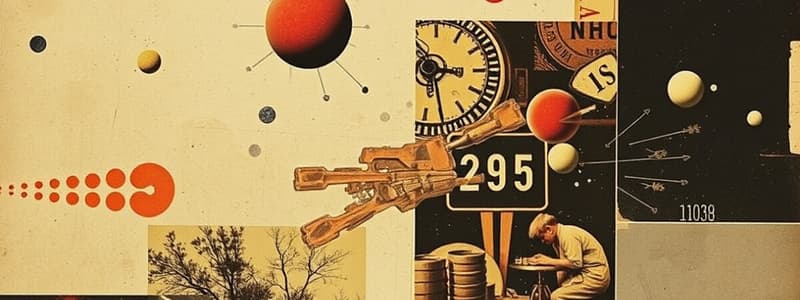Podcast
Questions and Answers
What is the particle arrangement in solids, and how does it affect their properties?
What is the particle arrangement in solids, and how does it affect their properties?
Particles in solids are tightly packed in a fixed, regular structure, giving them a definite shape and volume.
How does the particle arrangement in liquids differ from that in solids?
How does the particle arrangement in liquids differ from that in solids?
In liquids, particles are close together but can move past one another, allowing liquids to take the shape of their container.
What primarily determines the chemical properties of an atom?
What primarily determines the chemical properties of an atom?
The arrangement of electrons dictates the chemical properties of the element.
Describe the characteristics of gas particles in terms of arrangement and energy.
Describe the characteristics of gas particles in terms of arrangement and energy.
Differentiate between metals and non-metals based on their conductivity.
Differentiate between metals and non-metals based on their conductivity.
What are some indicators of a chemical change?
What are some indicators of a chemical change?
Define an element and provide an example.
Define an element and provide an example.
What is the difference between a chemical change and a physical change?
What is the difference between a chemical change and a physical change?
What is the main difference between a compound and a mixture?
What is the main difference between a compound and a mixture?
Explain the term 'latent heat' during phase transitions.
Explain the term 'latent heat' during phase transitions.
Explain the benefits of alloying metals.
Explain the benefits of alloying metals.
What happens to solid particles as temperature increases?
What happens to solid particles as temperature increases?
What kind of structure do lattice compounds form?
What kind of structure do lattice compounds form?
What is one of the key principles of Dalton's Atomic Theory regarding atoms?
What is one of the key principles of Dalton's Atomic Theory regarding atoms?
What characterizes monoatomic elements?
What characterizes monoatomic elements?
How do molecular compounds differ from lattice compounds?
How do molecular compounds differ from lattice compounds?
Name a method to prevent metal oxidation and briefly describe it.
Name a method to prevent metal oxidation and briefly describe it.
What role do periods in the periodic table play?
What role do periods in the periodic table play?
Flashcards are hidden until you start studying
Study Notes
States of Matter
- Solids: Particles are tightly packed in a fixed structure, resulting in a definite shape and volume. Particles vibrate without free movement due to lower energy.
- Liquids: Particles are close but can move past one another, giving liquids a definite volume while adapting to the shape of their container. They are incompressible and have more energy than solids.
- Gases: Particles are far apart and move freely, exhibiting neither a definite shape nor volume, making them highly compressible. Gas particles possess the highest energy, allowing rapid movement and expansion.
Energy and Temperature Changes
- Increasing temperature causes:
- Solids: More vigorous vibrations of particles.
- Liquids: Increased freedom of movement enhancing fluidity.
- Gases: Faster movement and greater spreading of particles.
- Decreasing temperature reverses these effects, potentially leading to phase changes like freezing or condensation.
Phase Transitions
- Melting: Transition from solid to liquid.
- Evaporation: Transition from liquid to gas.
- Condensation: Transition from gas to liquid.
- Freezing: Transition from liquid to solid.
- Sublimation: Transition from solid directly to gas.
- Deposition: Transition from gas directly to solid.
- During these changes, temperature remains constant while latent heat is absorbed or released.
Chemical vs. Physical Changes
- Chemical Changes: Result in new substances with different properties, often irreversible (e.g., rusting iron).
- Physical Changes: Alter appearance or state without changing chemical composition, generally reversible (e.g., melting ice).
Indicators of Changes
- Chemical Change Indicators: Color change, gas production, temperature change, or precipitate formation.
- Physical Change Indicators: Changes in state, shape, or size without altering composition.
Dalton's Atomic Theory
- Atoms are indivisible and consist of subatomic particles.
- Atoms of a single element are identical in mass and properties.
- Compounds form by combining atoms in fixed ratios.
- Chemical reactions rearrange atoms while conserving mass.
Structure of Matter
- Matter consists of atoms with a nucleus of protons and neutrons surrounded by electrons in orbitals, determining chemical properties.
Metals, Non-Metals, and Metalloids
- Metals: Good conductors of heat and electricity, malleable (e.g., iron, copper).
- Non-Metals: Poor conductors, often brittle (e.g., carbon, sulfur).
- Metalloids: Exhibit intermediate properties between metals and non-metals (e.g., silicon).
Periodic Table
- Periods: Horizontal rows indicating the number of electron shells.
- Groups: Vertical columns that show elements with similar chemical properties and valence electron configurations.
Elements vs. Compounds
- Element: Pure substance made of one type of atom (e.g., oxygen).
- Compound: Formed by chemically bonding two or more elements (e.g., water, H₂O).
Preventing Metal Oxidation
- Coating: Applications like paint or galvanization provide protection.
- Alloying: Mixing metals (e.g., stainless steel) enhances rust resistance.
- Cathodic Protection: Utilizing a more reactive metal to preferentially corrode instead of iron.
Monoatomic, Molecular, and Lattice Elements
- Monoatomic Elements: Single atoms not bonded to others (e.g., noble gases like He and Ne).
- Molecular Elements: Groups of bonded atoms (e.g., O₂ and N₂).
- Lattice Elements: Regularly arranged atoms in a lattice structure (e.g., diamond, NaCl).
Molecular vs. Lattice Compounds
- Molecular Compounds: Atoms share electrons through covalent bonds to form distinct molecules (e.g., H₂O, CH₄).
- Lattice Compounds: Ions or atoms form a repeating lattice structure held by ionic bonds (e.g., NaCl, MgO).
Key Terms and Definitions
- Atom: Smallest unit of an element retaining chemical properties, comprising protons, neutrons, and electrons.
- Element: Pure substance of one type of atom with unique properties (e.g., hydrogen, carbon).
- Compound: Formed from two or more elements bonded together in fixed ratios (e.g., H₂O, CO₂).
- Molecule: Group of bonded atoms, the smallest unit of a compound (e.g., water molecule).
- Mixture: Combination of substances that are physically combined; can be homogeneous or heterogeneous (e.g., air, salad).
- Lattice: Regular arrangement of atoms or ions in solids (e.g., configuration of diamond).
Studying That Suits You
Use AI to generate personalized quizzes and flashcards to suit your learning preferences.




